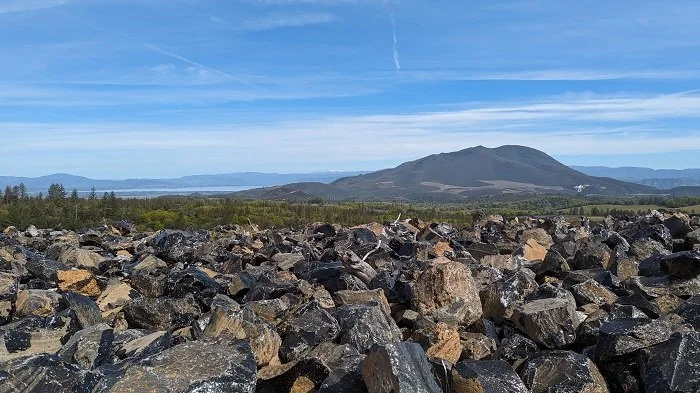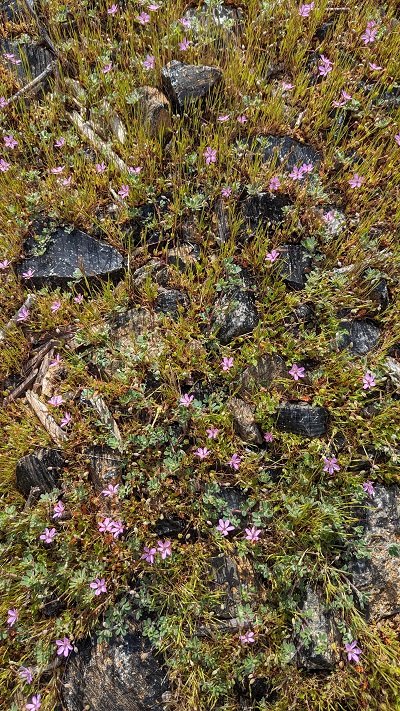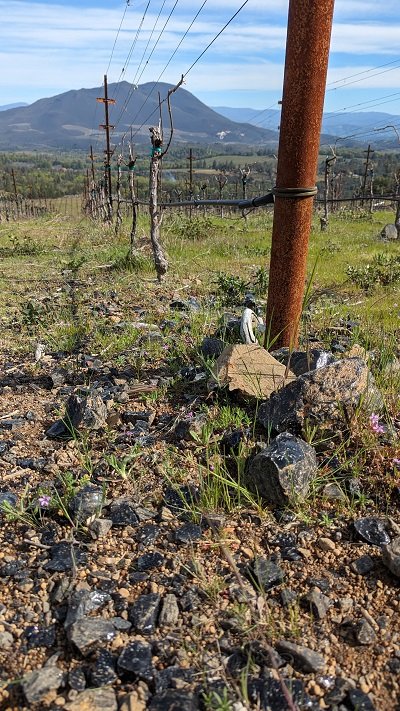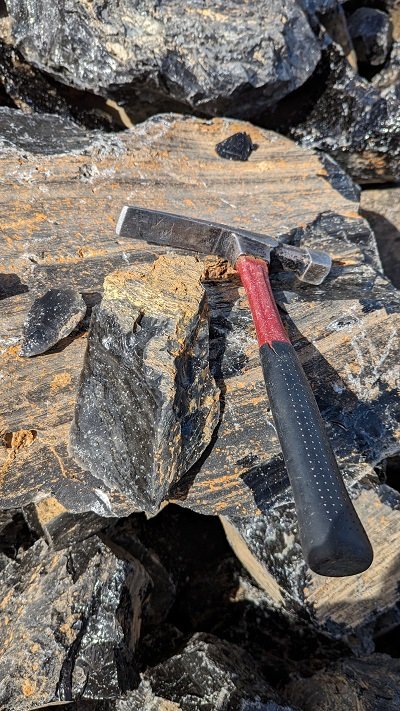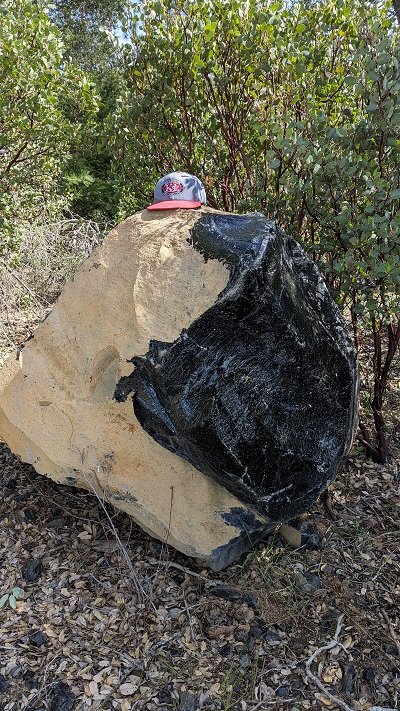Obsidian Ridge Crafts Exceptional Cabernet from Geologic Magic
Earlier this week I was lucky enough to be invited to the inaugural Volcano Camp at Obsidian Ridge Vineyard in the Clear Lake Basin. K&L’s partnership with Obsidian Ridge predates my 12 years with the company. I have long been a huge fan of their wines, and we have stocked them every vintage. However, up until this week I had never made it up to the vineyard in person. Now, let's be honest, it's not exactly a convenient place to drop in to when you're passing by! The vineyard sits on a remote mountain ridge in between Cobb Mountain and Mt Konocti in Lake County. At 2,975ft, the vineyard is the highest in the Mayacamas range.
As many of my colleagues will tell you, there are few things I enjoy more than traveling to vineyards that are inaccessible or situated in locations that seem highly challenging… but it makes sense to me that when you see someone who has gone about establishing a vineyard in a very remote or extreme location, there's likely a very good reason for doing so! Certainly vineyards like this aren't planted because they're easy to farm or economically efficient. More often than not then they're planted because someone passionately believes that the site has the potential to make exceptional and distinctive wines. However, what really blew my mind upon arriving to the vineyard was the radical soil composition of the site: the sheer amount of obsidian glass that makes up over 60% of the topsoil! Sure, I'd seen the photos and heard the stories, but nothing really prepared me for the reality of walking through the vineyard listening to the clinking, tinkling sounds of obsidian gravel under my feet. Surrounding the vineyard are huge piles and walls of glistening obsidian boulders from soccer ball-size up to some the size of a small car! It is truly stunning to see. For the highly educational camp program, Obsidian Ridge owners had enlisted the services of a USGS volcanologist/geologist studying then Clear Lake Basin to come and teach about the geological and tectonic formation of this region and about the composition of obsidian (a type of rhyolite) itself. The 500,000 year old lava flow that created this formation is very young geological terms and has weathered down very little hence the abundance of large rocks in the soil that are mixed into red volcanic clay loam.
After taking dozens of photos of shiny rocks and satisfying my primal desire to use the geologist’s hammer then splinter off some fresh fragments of obsidian glass (this area was also an historic place for Native American people who used and traded the obsidian from this flow with other tribes all across the country), I turned my attention to other attributes of the site beyond its fascinating rocks. Sitting at almost 3,000ft elevation, with very clear, dry air, the night time temperatures here can fall very low. In fact, the vineyard manager recounted that just a week before our visit, the vineyard was covered with a couple inches of icy snow. The vines at Obsidian Ridge are only just now, in the third week of April, showing the earliest signs of bud break around a month later than most of Napa Valley that has 3-6 inches of growth in most places currently. The late bud break here mitigates much of the frost danger in spring; however, come October the temperatures again will start falling below freezing at night and shutting down the vine’s foliage. The shorter growing season at this elevation is counterbalanced by very intense UV light from the sun meaning very efficient photosynthesis during the growing season.
To combat the intensity of the sun and heat during the mid-summer, the team at Obsidian Ridge have learned “leave the leaves”—meaning not to pull too many leaves off the vine to give plenty of dappled shade for the fruit and keep the vine’s full array of solar panels intact to promote full physiological ripening. Other things they've discovered since establishing the first block of the vineyard in 1999 is that the obsidian rich soils are very low in phosphorus and magnesium, two essential minerals for vine health and photosynthesis. Renowned viticulturist/consultant Dr. Paul Skinner who has many decades of experience in Napa Valley and across the globe joined the team to dial in these elements and get the vineyard optimally balanced. Though not organically certified, chemical inputs are very minimal. The very poor, rocky soils and limited water mean that very few plants grow here to compete with the vines eliminating the need for glyphosate herbicide. The low humidity, high UV and almost constant winds also mean this is a low disease pressure site as far as powdery mildew and other fungal and indeed insect-based threats. Tractor passes and sulfur sprays are kept to a minimum based on real-time assessment of the vineyard block by block rather than a standard regiment.
Winemaker Alex Beloz has crafted the wines at Obsidian Ridge for over a decade and knows the site intimately. His winemaking style never overpowers the special place in which the grapes grow, but he does enough to ensure the wines are beautifully polished and expressive. Over the years he’s dialed back extraction in favor of a more elegant tannin structure from a site that certainly can produce very big, firm wines. During the camp we tasted a fantastic flight of other volcanic terroir wines from across the globe including wines from Etna, Azores, Santorini, and closer to home on Pritchard Hill in Napa and Monte Rosso on Moon Mountain in Sonoma. I loved the fact that the team at Obsidian Ridge were not hesitant about showing their wines among some highly renowned producers and some significantly more expensive wines. It wasn’t a contest to see whose wines were “the best”—it was simply an exercise to see if a thread of volcanism could be perceived across the wines, but I always think it says something about a producer when they’re willing to let their own wines co-exist and show alongside others purely in the interest of trying to bring the bigger picture into focus. We actually tasted far more non-Obsidian Ridge wines at the event than ones produced on the property, yet I still came away with a much deeper understanding of this incredible place and even more respect and admiration for what the team here is trying, and very much succeeding, in doing.
2021 Obsidian Ridge "Volcanic Estate" Red Hills Lake County Cabernet Sauvignon $34.95 One of the best values in Cab across the entire selections at K&L. Thoughtfully, estate grown, high-elevation, mountain Cab, aged in high-end custom made cooperage, for $35!? This wine would be at least three to four times the cost in Napa. Beautifully fragrant dark fruits, cassis, blackberry, hints of espresso, cocoa powder, graphite, mountain chaparral, and wild thyme. Concentrated, but fresh and polished at the same time. Fine yet persistent tannins compliment the dark, ripe fruit. Soft and approachable to drink on its own, but with enough grip to work with steak, burgers, lamb. Exceptional value.
2021 Obsidian Ridge "Half Mile" Red Hills Lake County Cabernet Sauvignon $74.95 If you really want to see what this estate can do then take a swing with the “Half Mile” reserve bottling. A meticulous barrel selection of the highest and blocks on the property that receive the most extreme temperatures, winds, and intensity of sunlight. Grown in a bed of fractured obsidian glass with lenses of red, volcanic clay loam in between the pure rock. It basically just an amplified and even further polished version of the Volcanic Estate Cab, a distilling of the unique flavors and textures of this site taken to the nth degree with exacting winemaking, patience and dedication to the terroir. Slightly redder fruited with redcurrant, ripe raspberry, brambly fruit, exotic Asian spice, and some almost sandalwood notes; a very lifted and potent wine with beautiful purity. Crushed rock mineral tones also come through in spades.. It has such a wonderfully elegant, refined structure. This could certainly age for 20 years…but it’s absolutely delicious right now, too!
- Ryan Woodhouse, K&L Domestic Wine Buyer



